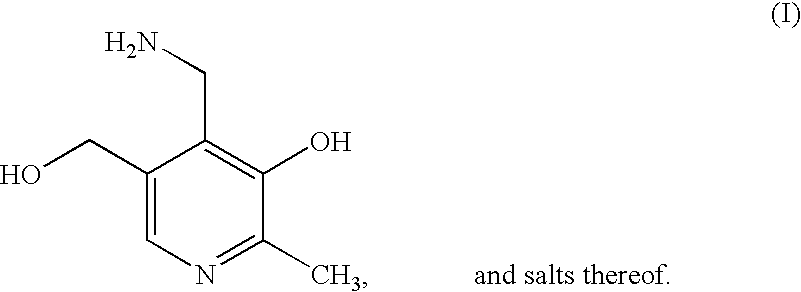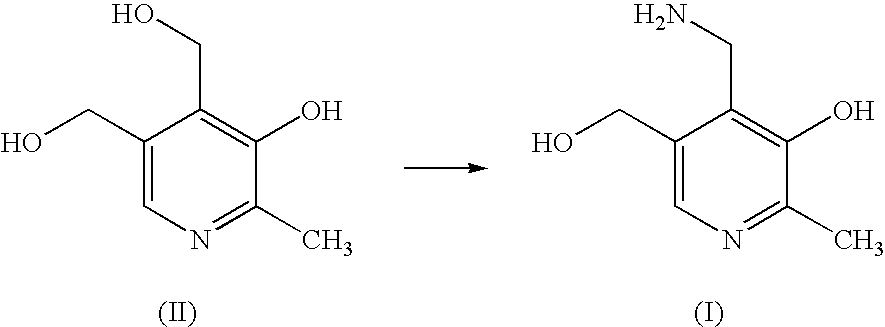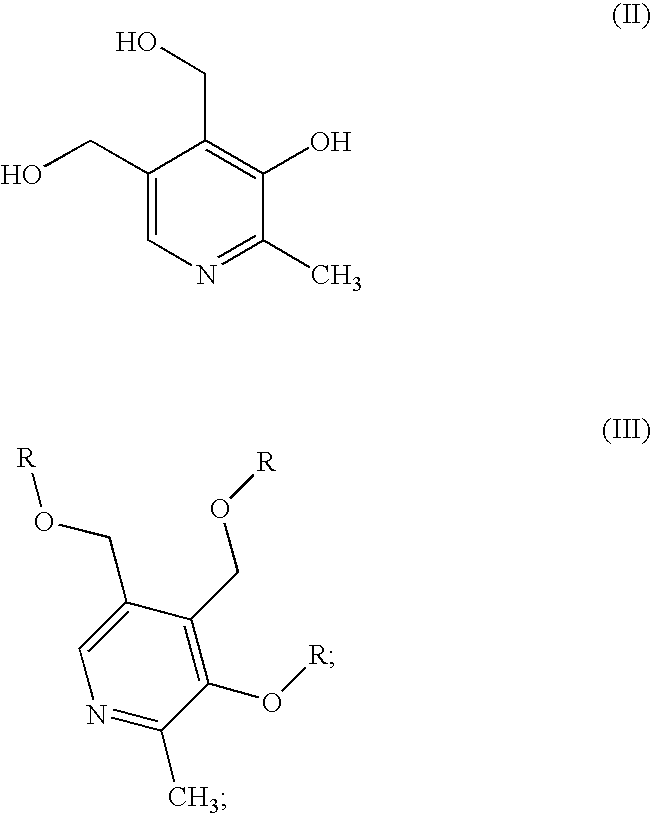Methods for the synthesis of pyridoxamine
a technology of pyridoxine and pyridoxamine, which is applied in the direction of biocide, drug composition, metabolic disorder, etc., can solve the problems of non-selective oxidation of the second hydroxymethyl group at the 5 and the problem of pyridoxine oxidation is problemati
- Summary
- Abstract
- Description
- Claims
- Application Information
AI Technical Summary
Problems solved by technology
Method used
Image
Examples
examples
[0145] Abbreviations used throughout the Examples are provided below.
AbbreviationMeaning% a / aPurity in %, for absorption factors not correctedACNAcetonitrileDMSODimethyl sulphoxideEq.EquivalentsEtOAcEthyl acetateGLCGas chromatographyHPLCHigh Performance Liquid Chromatographyi.t.Inner temperatureLODLoss on dryingMin.MinimalNEt3TriethylamineOPOrganic layerr.t.Room temperature (≈22° C.)s.m.Starting materialtbdto be determinedTBMEtert-Butyl-methyl-etherTemp.TemperatureTHFTetrahydrofuranTLCThin layer chromatographyTMSTetramethylsilane
[0146]
Synthesis
[0147] A 160 L reactor was inertised and charged with pyridoxine hydrochloride (II) (15.915 kg) in TBME (46 L). Acetic anhydride (3.25 eq., 24.5 L) was added and the suspension was heated to 50° C. Triethylamine (4 eq., 43 L) was added slowly over a period of 1 hour. During the addition of triethylamine, the inner temperature increased to 65° C. The mixture was stirred at reflux temperature for 1.5 hours. The reaction was completed when TL...
example 2
Preparation of Phthalimido-Derivative (D)
[0152]
[0153] A 160 L reactor was inertised and charged with the product from Example 1 in TBME (22.367 kg (C), 121 L). The solution was concentrated to a volume of about 40 L, under reduced pressure and a jacket temperature of 60° C. To the reduced volume was added DMSO (50 L). The distillation of TBME was continued until 1H NMR showed 5.4 mol % of residual TBME (compared to amount of (C); limit: 10 mol %). To this was added DMSO (7.5 L), phthalimide potassium salt (1.3 eq., 18.211 kg), and THF (9 L) and the mixture was stirred at 40° C. for 34.hr. At this point 1H NMR showed 98.2% conversion to (D).
[0154] The reaction mixture was cooled to 20° C. and divided into two portions (2×50 L). To each portion THF (45 L and 44.5 L), water (11 L and 12 L), and half-saturated NaCl (25 L and 23.5 L) were added, and the resulting aqueous and organic layers were separated. The combined aqueous layers were extracted with THF (3×20 L). The combined organi...
example 3
Preparation of Methylamide Derivative of Pyridoxamine (V)
[0160]
[0161] A 160 L reactor was inertised and charged with the product of Example 2 in THF (26.216 kg (D) in 133 L). The solution was heated to 48-50° C. and propylamine (4 eq., 25.1 L) was added over a period of 33 minutes (temperature increased to 55° C. during addition). The reaction mixture (solution) was stirred at 65° C. for 15 h. A suspension formed. 1H NMR showed conversion >99% (compared to intermediate with signal at δ=5.23 ppm, 2 H).
[0162] The suspension was cooled to 5° C. over a period of 1 h and stirred at this temperature for 40 min. The suspension was filtered over a wet celite bed (2.403 kg Celite, 10 L THF) to give a clear orange mother liquid. The filtration was quite slow (˜7.5 h). The filter cake (crude 1#1—phthalic acid dipropylamide) was washed with cold (5° C.) THF (2×48 L). The combined organic layers (215 L) were concentrated to a volume of about 30 L at a 60° C. jacket temperature under reduced pr...
PUM
| Property | Measurement | Unit |
|---|---|---|
| temperature | aaaaa | aaaaa |
| concentration | aaaaa | aaaaa |
| temperature | aaaaa | aaaaa |
Abstract
Description
Claims
Application Information
 Login to View More
Login to View More - R&D
- Intellectual Property
- Life Sciences
- Materials
- Tech Scout
- Unparalleled Data Quality
- Higher Quality Content
- 60% Fewer Hallucinations
Browse by: Latest US Patents, China's latest patents, Technical Efficacy Thesaurus, Application Domain, Technology Topic, Popular Technical Reports.
© 2025 PatSnap. All rights reserved.Legal|Privacy policy|Modern Slavery Act Transparency Statement|Sitemap|About US| Contact US: help@patsnap.com



